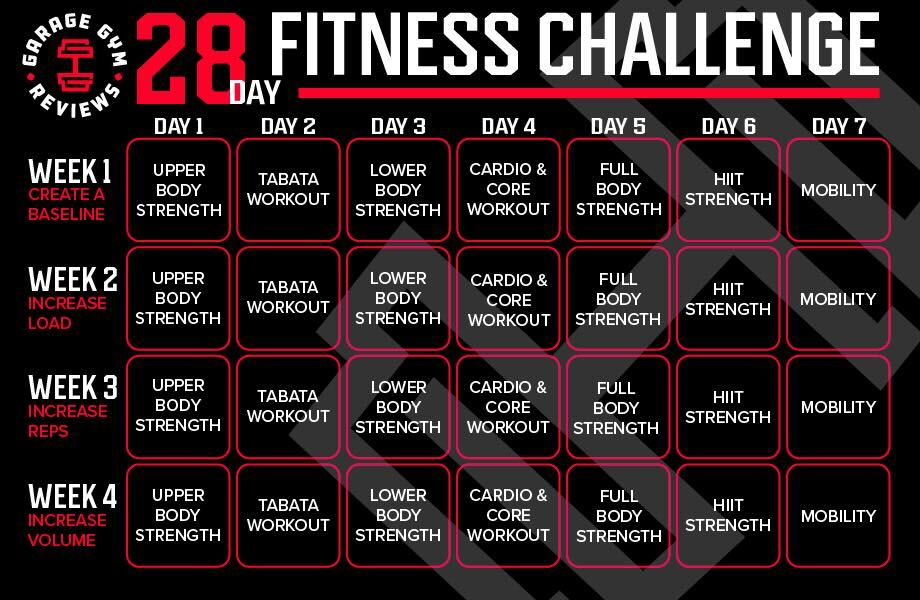28-Day Workout Challenge: Four Weeks of Progress and Accountability
The GGR Expert Panel is a network of specialized health and fitness professionals who help ensure we present the most accurate information to our readers. This includes physicians, certified trainers, elite-level coaches, and more. Learn more about our experts.
Expert Verified by Nicole Davis, CPT, PN1-NC
UPDATED JANUARY 31, 2023

We test and review fitness products based on an independent, multi-point methodology. If you use our links to purchase something, we may earn a commission. Read our disclosures.
Each Week Has A New Challenge To Keep Developing Your Strength
Medical disclaimer: This article is intended for educational and informational purposes only. It is not a substitute for health or medical advice. For medical advice, contact an appropriate healthcare provider.
As a certified personal trainer, I’ve worked with everyone from teenagers to senior citizens and beginners to athletes. To develop a program for anyone at any age, exercise selection is just part of the process for an effective total-body strength program.
The other part is developing a program that incorporates repetition and a clear path toward progression. Adding more weight1 to any given exercise might be your first instinct about how to get stronger, but it’s not the only method. Over the course of this 28 day workout challenge, you will incrementally change your weight, repetitions, and sets so that your overall training volume (and performance) improves by the fourth week.
Is This Challenge For Me?
If you’re looking to kickstart your home workout fitness routine, but you’re unsure where to start—look no further. This challenge is intended for beginners, but can be customized and adapted for any fitness level. This 28-day challenge has a workout routine with a mix of strength, conditioning, and mobility to create a well-rounded workout program and establish a habit of meeting (or exceeding) the CDC2 recommendation of 150 minutes of moderate to vigorous exercise for adults.
This challenge not only has a clear plan for the next four weeks, but a fillable chart to track all of your progress. Each week the movements will be the same, but you will be challenged to either add weight, reps, or sets to your workout—I will explain all the details later.
One thing to keep in mind is starting a new routine of any sort can be a downright struggle. A commitment to leading a healthier, stronger life is more about action than anything else, which as we all know is that hardest part.
A 2020 study3 from Frontiers in Psychology found that forming a new routine is more likely to become habitual when it is frequently and consistently performed in the same context (like time of day or location).
According to the same study, building a new habit on top of your regular routine can also help habit formation. The study referred to this as a co-occurrence of context and behavior. For example, if you frequently and consistently take a walk after lunch, it’s likely that this action over time will become habitual and rather effortless to act on.
What Will I Accomplish In 28 Days?
Here’s the thing: I can’t guarantee you’re going to look leaner and more muscular after 28 days. I know we’re all after quick fixes and eight-minute abs, but that’s not really how our bodies change.
I can, however, assure you that you will feel positive changes every time you workout. After just one workout, you are sure to feel muscle fatigue and perhaps even a boost of endorphins4, which is great, but we’ll need to do a lot more than one workout for muscle gains.
After just a few workouts, your body undergoes neurological changes5 that make it easier to perform the same exercise next week, even with the same load (or heavier). These neurological changes happen because your brain sends messages through your nerves and muscle fibers to engage a particular muscle or group of muscles.
After a duration of regular exercise—weeks, months, or even years—the body undergoes chronic adaptations, which are the kind of lasting changes we’re all seeking. Not only do our muscles have the chance to get stronger and grow larger, the tendons and ligaments that help connect our muscles to our bones also develop and get stronger as well.
Additionally, regular strength training can stimulate new bone cell formation5 (aka bone density). The tissue inside our bones is not only dynamic, but we can stimulate new bone cell formation when we engage in exercise that puts strain or impact on our bones. I know strain sounds rather intense, but all I mean by that is exercise that adds load (like resistance training) or exercise that requires impact to the skeletal system (like HIIT training, running, and even walking).
How To Follow The 28 Day Challenge: Don’t Stray, Just Repeat
For the love of strength and conditioning, please don’t quit because you’re bored. This isn’t happy hour with your besties. Strength training is low on drama and high on repetition.
For the 28-day challenge, the movements and prescribed exercises will not change. What you will notice is the suggested sets, repetitions, and load are the variables.
You can start your challenge on any day of the week that suits you—meaning you don’t have to wait for a Monday! Here is the basic outline you’ll be following:
- Day 1: Upper body strength
- Day 2 Tabata workout
- Day 3: Lower body strength
- Day 4: Cardio and core workout
- Day 5: Full body strength
- Day 6: HIIT workout
- Day 7: Mobility
How To Progress During The 28-Day Workout Challenge
Each week is going to present a new challenge. The exercises won’t change from week-to-week—instead you will add either more weight, more repetitions, or more sets from the previous week. This ensures you keep practicing good form and get in your volume.
Before we get into the details of how each week will challenge you differently, I’m going to ask you to write down the weight you use, how many repetitions, and how many sets you performed for every workout. Use the fillable chart to quickly jot down your data to ensure that you’re not guessing when it comes to making progress.
Week One: Create A Baseline
I highly suggest trying a lot of these exercises with your bodyweight only on the first set (or two). To your own comfort level, use dumbbells, kettlebells, or resistance bands to add resistance. Keep in mind that this first week you’ll want to keep overall soreness fairly low, so you can recover and be ready for the next workout.
Week Two: Increase Load
Once you’ve established a baseline on week one, the next week is about increasing the load. Plan to increase the amount of weight (or band resistance) for any exercise you feel comfortable with adding more of a challenge. For example, you can swap out a 20-pound dumbbell for a 25-pound dumbbell on a single-arm row for all (or most) of your sets.
Week Three: Increase Repetition
Now that you’ve added a little weight from the very first week, this third week will focus on adding repetition. The intention is to increase the amount of repetitions performed on each set, while keeping the load the same. For example, if you increase your single-arm dumbbell row to 25 pounds last week (and it went well), you can now go from 10 repetitions to 12 on all three sets.
Week Four: Increase Volume
This last week is going to tack on even more of a challenge by having you add another whole set your routine. What this means is that instead of three rounds of every exercise, you’re going to increase that to four sets. This increases the total number of repetitions performed at the end of a workout. Using the same example, you will row with 25 pounds, at 12 reps, and increase the total sets from three to four (aka a longer workout with more repetition).
What Equipment Will I Need?
Although you won’t need an elaborate home gym set up for this 28-day challenge, you will need a few things:
- Floor space/workout mat
- Mini-loop resistance bands
- Tube resistance bands or loop resistance bands
- Dumbbells (or kettlebells, sandbags, water jugs, loaded book bags, etc.)
The Full 28-Day Schedule
Here is what you can expect from the next 28 days.

| Day 1 | Day 2 | Day 3 | Day 4 | Day 5 | Day 6 | Day 7 | |
| Week 1: Create a Baseline | Upper-body strength | Tabata workout | Lower-body strength | Cardio and Core workout | Full-body strength | HIIT workout | Mobility |
| Week 2: Increase Load | Upper-body strength | Tabata workout | Lower-body strength | Cardio and Core workout | Full-body strength | HIIT workout | Mobility |
| Week 3: Increase Repetition | Upper-body strength | Tabata workout | Lower-body strength | Cardio and Core workout | Full-body strength | HIIT workout | Mobility |
| Week 4: Increase Volume | Upper-body strength | Tabata workout | Lower-body strength | Cardio and Core workout | Full-body strength | HIIT workout | Mobility |
28-Day Workout Challenge Workouts
Below you can download the entire workout chart where you can track your weekly progress. Additionally, we’ve broken down each workout below.
FitnessChallenge-InteractivePDFDownload
To read the entire article with animation please go to GARAGE GYM REVIEWS

Lauren Strong CPT
Lauren is an NSCA-Certified Personal Trainer with six years of experience working with clients of all skill levels. Lauren specializes in coaching the squat, bench, and deadlift and enjoys introducing beginners to barbell training. Before her career as a CPT, Lauren spent three years in a marketing role for credit unions after graduating from the University of Maine with a BA in Journalism. Lauren spends her leisure time trying new recipes, reading fiction, or taking nature walks. She lives in Maine with her husband and two cats.





